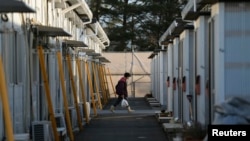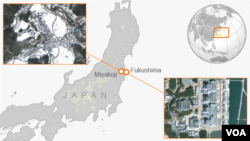TAMURA, JAPAN —
People in Japan on Tuesday began their first homecomings in three years to a small area evacuated after the Fukushima disaster, but families are divided as worries about radiation and poor job prospects have kept many away.
The reopening of the Miyakoji area of Tamura, a city 140 miles northeast of Tokyo and inland from the wrecked Fukushima nuclear station, marks a tiny step for Japan as it attempts to recover from the 2011 disasters.
But the event is a major milestone for the 357 registered residents of the district. The trickle of returnees highlights both people's desire to return to the forested hamlet and the difficulty of returning to normal.
“Many of our friends and neighbors won't come back,” said Kimiko Koyama, 69, speaking on her return to the large farmhouse she had occupied for 50 years, while her husband Toshio, 72, tried to fix a television antenna on the roof.
“There are no jobs. It's inconvenient and young people are scared of radiation,” she said. “My daughter won't bring our grandsons here because of the radiation.”
Miyakoji, set amid rolling hills and rice paddies, has been off-limits to most residents since March 2011, when the government ordered evacuations after a devastating earthquake and tsunami triggered a triple meltdown at the power plant on the Pacific coast about 12 miles away.
“The evacuation period was long, but I am happy that we can finally return home,” said Tamura Mayor Yukei Tomitsuka. “For Tamura and its families, this is a fresh start.”
Thirty minutes to play
It is the first area in the 12-mile Fukushima exclusion zone to be reopened as decontamination was completed, paving the way for more towns to be resettled.
The government had planned to lift the Miyakoji ban in late October but opposition by residents delayed the move.
A few cars streamed into the town, where several TV news vans were set up. Some elderly women sat by the roadside, but there were no children or families in sight outside.
Schools open later this week, but seven children came to the local pre-school and four older children were also dropped off, as volunteers from nuclear plant operator Tokyo Electric Power removed ice and snow and leveled the playground.
Children in temporary homes outside the evacuation zone got 30 minutes to play outdoors each day, but how long they will spend outdoors now they are home has yet to be decided.
“We explain to them, 'There are bad germs outside and if you stay out too long, the germs will get inside your body,’” one teacher said. “Most of them understand.”
The 2011 crisis forced more than 160,000 people from towns near the Fukushima plant to evacuate. About a third still live in temporary housing across the prefecture, their lives on hold as they wait for Japan to finish decontamination.
Kitaro Saito, who is in his early 60s, will stay outside Miyakoji, despite wanting to return to his large hillside house there, because he thinks the government is using residents as “guinea pigs” to test if more people can return home.
“Relatives are arguing over what to do,” he said, warming his hands outside his temporary home among rows of other one-room trailers. “The town will be broken up.”
Radiation risk
Japan's $30 billion cleanup of radioactive fallout around Fukushima is behind schedule and not expected to achieve the long-term radiation reduction goal - 1 millisievert per year - set by the previous administration.
Across Fukushima prefecture, hundreds of workers are still scraping top soil, cutting leaves and branches off trees and hosing down houses to lower radiation levels.
Radiation levels in Miyakoji ranged from 0.11 microsieverts to 0.48 microsieverts per hour, February readings show.
That was higher than the average 0.034 microsieverts per hour measured in central Tokyo on Monday, but comparable to background radiation of about 0.2 microsieverts per hour in Denver. A commercial flight between Tokyo and New York exposes passengers to about 10 microsieverts per hour.
People exposed to radiation typically have a higher chance of getting cancer if doses exceed 100 millisieverts (100,000 microsieverts), according to the World Health Organization.
Tuesday's homecoming is particularly difficult, as many residents worked at the Fukushima plant before the disaster and depended on Tepco for stable jobs.
“It was the only job out here and we were grateful,” said Kimiko Koyama. “We worked hard to feed our three daughters. We worked and we built our life here.”
The Koyamas, who helped to build the very nuclear reactors that have displaced them from their homes, are letting the city keep radioactive debris in an empty lot on their land in a bid to hasten the cleanup.
The reopening of the Miyakoji area of Tamura, a city 140 miles northeast of Tokyo and inland from the wrecked Fukushima nuclear station, marks a tiny step for Japan as it attempts to recover from the 2011 disasters.
But the event is a major milestone for the 357 registered residents of the district. The trickle of returnees highlights both people's desire to return to the forested hamlet and the difficulty of returning to normal.
“Many of our friends and neighbors won't come back,” said Kimiko Koyama, 69, speaking on her return to the large farmhouse she had occupied for 50 years, while her husband Toshio, 72, tried to fix a television antenna on the roof.
“There are no jobs. It's inconvenient and young people are scared of radiation,” she said. “My daughter won't bring our grandsons here because of the radiation.”
Miyakoji, set amid rolling hills and rice paddies, has been off-limits to most residents since March 2011, when the government ordered evacuations after a devastating earthquake and tsunami triggered a triple meltdown at the power plant on the Pacific coast about 12 miles away.
“The evacuation period was long, but I am happy that we can finally return home,” said Tamura Mayor Yukei Tomitsuka. “For Tamura and its families, this is a fresh start.”
Thirty minutes to play
It is the first area in the 12-mile Fukushima exclusion zone to be reopened as decontamination was completed, paving the way for more towns to be resettled.
The government had planned to lift the Miyakoji ban in late October but opposition by residents delayed the move.
A few cars streamed into the town, where several TV news vans were set up. Some elderly women sat by the roadside, but there were no children or families in sight outside.
Schools open later this week, but seven children came to the local pre-school and four older children were also dropped off, as volunteers from nuclear plant operator Tokyo Electric Power removed ice and snow and leveled the playground.
Children in temporary homes outside the evacuation zone got 30 minutes to play outdoors each day, but how long they will spend outdoors now they are home has yet to be decided.
“We explain to them, 'There are bad germs outside and if you stay out too long, the germs will get inside your body,’” one teacher said. “Most of them understand.”
The 2011 crisis forced more than 160,000 people from towns near the Fukushima plant to evacuate. About a third still live in temporary housing across the prefecture, their lives on hold as they wait for Japan to finish decontamination.
Kitaro Saito, who is in his early 60s, will stay outside Miyakoji, despite wanting to return to his large hillside house there, because he thinks the government is using residents as “guinea pigs” to test if more people can return home.
“Relatives are arguing over what to do,” he said, warming his hands outside his temporary home among rows of other one-room trailers. “The town will be broken up.”
Radiation risk
Japan's $30 billion cleanup of radioactive fallout around Fukushima is behind schedule and not expected to achieve the long-term radiation reduction goal - 1 millisievert per year - set by the previous administration.
Across Fukushima prefecture, hundreds of workers are still scraping top soil, cutting leaves and branches off trees and hosing down houses to lower radiation levels.
Radiation levels in Miyakoji ranged from 0.11 microsieverts to 0.48 microsieverts per hour, February readings show.
That was higher than the average 0.034 microsieverts per hour measured in central Tokyo on Monday, but comparable to background radiation of about 0.2 microsieverts per hour in Denver. A commercial flight between Tokyo and New York exposes passengers to about 10 microsieverts per hour.
People exposed to radiation typically have a higher chance of getting cancer if doses exceed 100 millisieverts (100,000 microsieverts), according to the World Health Organization.
Tuesday's homecoming is particularly difficult, as many residents worked at the Fukushima plant before the disaster and depended on Tepco for stable jobs.
“It was the only job out here and we were grateful,” said Kimiko Koyama. “We worked hard to feed our three daughters. We worked and we built our life here.”
The Koyamas, who helped to build the very nuclear reactors that have displaced them from their homes, are letting the city keep radioactive debris in an empty lot on their land in a bid to hasten the cleanup.







